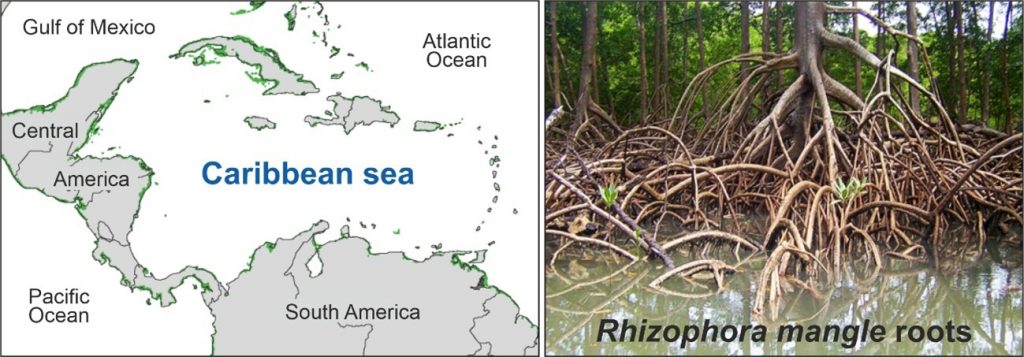Rise and fall of Caribbean mangroves
- Tropical mangrove forests protect other coastal ecosystems, maintain land/sea biodiversity and are the most efficient blue-carbon ecosystems, contributing to mitigate global warming.
- According to recent estimates, the Caribbean mangroves, which emerged 50 million years ago, might disappear in less than a century due to deforestation.
Mangrove forests form a distal continental fringe along the tropical/subtropical coasts hat protect coasts and other coastal ecosystems (corals, seagrasses, salt marshes) from erosion and develop a complex physical structure that favors habitat and niche diversification, which allows many terrestrial and aquatic species to thrive, thus enhancing biodiversity and ecological complexity. Mangroves not only provide ecological and cultural services but also contribute to the mitigation of global warming. These communities, along with seagrasses and salt marshes, are among the most important blue-carbon ecosystems, acting as efficient carbon sinks and contributing to the alleviation of atmospheric CO2 increase. Presently, however, mangroves are among the world’s most threatened ecosystems due to natural and anthropogenic deforestation.

The Caribbean region with the mangrove areas highlighted in green (left) and the aerial roots (pneumatophores) of Rhizophora mangle, the dominant tree in the Caribbean mangroves (right).
The Caribbean is one of the main mangrove hotspots, and the most relevant threats are urbanization, damming, agriculture, forestry, tourism, fisheries, salt production and shrimp farming. According to recent estimates, the Caribbean mangroves have been reduced by ~7000 km2 in only three decades (1980-2010), which means a one-third reduction, at an average rate of >230 km2 per year (Rull, 2022). At these rates, the Caribbean mangroves could disappear in the next 60 years.
| Comparison of mangrove extent (km2) in the Caibbean coasts, between 1980 and 2010 (Rull, 2022). | ||
|---|---|---|
| Country/island | 1980 | 2010 |
| Anguilla (UK) | <1 | 1 |
| Antigua & Barbuda | 16 | 8 |
| Aruba | 4 | <1 |
| Barbados | <1 | <1 |
| Belize | 785 | 445 |
| Cayman Islands (UK) | 10 | 41 |
| Colombia | 4400 | 2622 |
| Costa Rica | 634 | 365 |
| Cuba | 5374 | 3328 |
| Dominican Republic | 344 | 187 |
| El Salvador | 467 | 376 |
| Grenada | 3 | 2 |
| Guadeloupe (France) | 30 | 37 |
| Guatemala | 186 | 235 |
| Guyana | 910 | 286 |
| Haiti | 178 | 144 |
| Honduras | 1525 | 597 |
| Jamaica | 120 | 94 |
| Martinique (France) | 19 | 21 |
| Nicaragua | 1034 | 740 |
| Panama | 2500 | 1533 |
| Puerto Rico | 77 | 87 |
| Saint Kitts & Nevis | <1 | <1 |
| Saint Lucia | 2 | 16 |
| Saint Vincent & the Grenadines | <1 | <1 |
| Trinitat & Tobago | 75 | 77 |
| Venezuela | 2600 | 2753 |
| Virgin Islands (US and UK) | 10 | 21 |
| Caribbean Total | 21300 | 14000 |
In conservation discussions, it is often said that what evolution has taken millions of years to develop might be lost in centuries. In the case of Caribbean mangroves, this asymmetry may be quantified, as these ecosystems originated ~50 million years ago and, if current loss rates are maintained, they may disappear in less than a century (Rull, 2023). During their evolution, the Caribbean mangroves endured mass extinctions, paleogeographic reorganizations, glacial-interglacial climatic cycles and dramatic sea-level shifts. However, human pressure might be able to “instantaneously” erase these forests from the face of the earth. Mangrove decline has slowed thanks to recent protection actions, but this will only delay their loss for several decades. Regional-wide coordinated and more effective conservation measures are needed to avoid mangrove vanishing in the Caribbean region.
References:
-
Rull, V. 2022. Responses of Caribbean mangroves to Quaternary climatic, eustatic and anthropogenic drivers of ecological change. Plants 11, 3502.
-
Rull, V. 2023. Rise and fall of Caribbean mangroves. Science of the Total Environment (in press).














